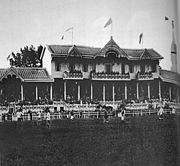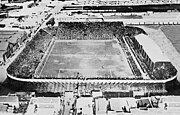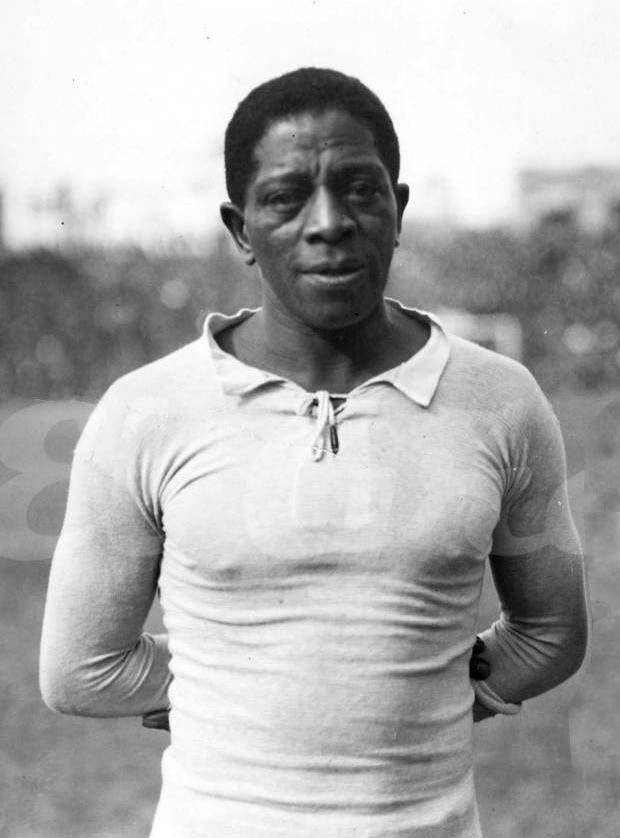Campeonato Sudamericano 1916
| Campeonato Sudamericano 1916 | |
|---|---|
| Soccer South American Championship 1916 | |
| Number of nations | 4th |
| South American champions |
|
| venue |
|
| Opening game | July 2, 1916 |
| Tournament end | July 17, 1916 |
| Games | 6th |
| Gates | 18 (⌀: 3 per game) |
| spectator | 84,200 (⌀: 14,033 per game) |
| Top scorer |
|
| Best player |
|
| References | 0 (⌀: 0 per game) |
The 1916 South American Championship was the first recognized South American Championship in football and also the first continental championship of national soccer teams worldwide. It took place from July 2nd to 17th on the occasion of the 100th anniversary of the independence of the United Provinces of the Río de la Plata in Argentina . Since the four participants from Argentina , Brazil , Chile and Uruguay founded the South American football association CONMEBOL on the initiative of the Uruguayan Héctor Rivadavia during the tournament on July 9, 1916, the anniversary of Argentina's independence, the Campeonato of 1916 is considered the first Copa America, albeit six years earlier, a competition of the same name and of a similar design was held to mark the anniversary of the Argentine May Revolution . The trophy, bearing the name Copa América from the very beginning, has not yet been played, but introduced for the first official appointment in 1917 .
The games took place in the Estadio GEBA of the Club de Gimnasia y Esgrima in Buenos Aires . The decisive game between Uruguay and Argentina was canceled after 5 minutes due to "incidents" and continued the next day at the Estadio Racing Club of the Racing Club in Avellaneda , which is now the Estadio Presidente Perón . The hosts' 6-1 success against Chile took place in front of the tournament's record crowd of 18,000 spectators. The opening game between Uruguay and Chile, which only 3,000 people wanted to see, was by far the least popular. All other games took place in front of at least 15,000 spectators.
The most prominent player, at least in retrospect, was arguably the first Brazilian striker, Arthur Friedenreich , who scored the 1-0 goal in the game against Uruguay.
|
Game results
With one exception, all games took place in Buenos Aires .
| Pl. | country | Sp. | S. | U | N | Gates | Diff. | Points |
|---|---|---|---|---|---|---|---|---|
| 1. |
|
3 | 2 | 1 | 0 | 6: 1 | +5 | 5: 1 |
| 2. |
|
3 | 1 | 2 | 0 | 7: 2 | +5 | 4: 2 |
| 3. |
|
3 | 0 | 2 | 1 | 3: 4 | −1 | 2: 4 |
| 4th |
|
3 | 0 | 1 | 2 | 2:11 | −9 | 1: 5 |
| Sun, July 2, 1916 | |||
| Uruguay | - | Chile | 4: 0 (1: 0) |
| Thursday, July 6, 1916 | |||
| Argentina | - | Chile | 6: 1 (1: 1) |
| Sat, July 8, 1916 | |||
| Chile | - | Brazil | 1: 1 (0: 1) |
| Mon., July 10, 1916 | |||
| Argentina | - | Brazil | 1: 1 (1: 1) |
| Wed., July 12, 1916 | |||
| Uruguay | - | Brazil | 2: 1 (0: 1) |
| Mon., July 17, 1916 in Avellaneda | |||
| Argentina | - | Uruguay | 0-0 |
Uruguay and Argentina were considered the strongest teams in South America at the time. Both countries had played around 40 games against each other in their international history since 1902, while Chile played their eighth and Brazil only their third. The start of Uruguay against Chile was accordingly clear. José Piendibene was only able to take the lead in the 44th minute , but three more goals followed in the second half, with both Piendibene and Isabelino Gradín scoring a brace. Uruguay were initially behind in their second game against Brazil, but after an hour top scorer Gradín equalized. This was followed by the winning goal by José Tognola ten minutes before the end of the game . In the last game against the traditional enemy Argentina at the time, a draw was enough to become the first South American champion in history before the hosts.
Argentina also got off to a good start against Chile. Alberto Ohaco made it 1-0 after just two minutes , but Chile equalized before the break. In the second half, however, a clear victory was achieved, which was leveled by two converted penalties from Juan Domingo Brown . At the end of the game, in addition to Brown, two other players had each scored a double: Alberto Marcovecchio and Ohaco. Argentina, unlike Uruguay, took an early lead against Brazil, but then had to accept the equalizer 13 minutes later. It stayed in a draw, so Argentina definitely needed a home win in their last game. Due to overcrowding in the stadium, the game was interrupted and continued one day later in the sixth minute. A goalless draw was only enough for the Argentines to finish second.
Brazil met Chile in their first game, but only achieved a sobering draw in their third international match. After Demósthenes had taken the lead five minutes before half-time, Brazil believed they were on the road to victory until shortly before the end. Chile equalized in the 84th minute, so that they only got one point out of the game. After another draw with Argentina, Brazil had to win high against Uruguay and hope for an Uruguayan win against Argentina or a draw in order to have any chance of the title. Arthur Friedenreich took the lead for Brazil in the 8th minute . But in the final phase Uruguay turned the game around so that Brazil finished third with only two points.
Chile had no chance in the fight for the South American crown. As in other international matches against Uruguay and Argentina - so far there had only been meetings with these countries - you lost quite clearly. A clear defeat by Uruguay, which went almost a full half without conceding , was followed by another major defeat by Argentina, with Telésforo Báez scoring the first goal in Chilean Copa America history. When the Chileans were already eliminated, they could still achieve a late point of honor against Brazil, which meant the first point win in their international history.
Goal scorers
The goal scorers are listed below. The sorting takes place according to the number of hits, with the same number of goals alphabetically.
|
referee
A total of four referees took part in the Campeonato Sudamericano. There was a referee for each participating country at the tournament. Interestingly, these were not necessarily special referees, but rather players or coaches from a participating country.
| referee | vintage | Games | Penalty kick | Space management | annotation |
|---|---|---|---|---|---|
|
Carlos Fanta |
1890 | 3 | 0 | 0 | Coach of Chile |
|
Hugo Gronda |
? | 1 | 0 | 0 | |
|
Leon Peyrou |
? | 1 | 0 | 0 | |
|
Sidney Pullen |
1895 | 1 | 2 | 0 | Brazil player |
Web links
- IFFHS: Explanations for the introduction of the Copa America
- Tournament website 1916 at rsssf.com (engl.)
Individual evidence
- ↑ Copa América Best Players on RSSSF
- ↑ Eugenio Figueredo will attend the tribute to Héctor Rivadavia Gómez on conmebol.com, May 11, 2013, accessed July 27, 2016
- ↑ Copa América 1916-2016 - Historical Records on RSSSF.com, July 6, 2016, accessed July 23, 2016
- ↑ EL ORIGEN CATALÁN DE LA COPA AMÉRICA on sobrecesped.com, accessed July 27, 2016






